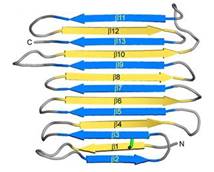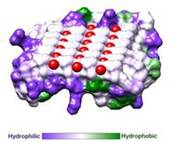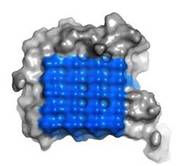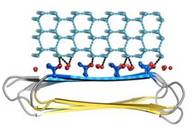RiAFP
From Proteopedia
(Difference between revisions)
| Line 3: | Line 3: | ||
== Function == | == Function == | ||
| - | RiAFP, like other AFPs, adsorb to the surface of ice crystals and lower the temperature at which these crystals grow. Consequently, creating a difference between the melting point and the freezing point known as thermal hysteresis (TH), within which the ice growth is arrested<ref>DOI 10.1098/rsif.2014.0526</ref>. | + | RiAFP, like other AFPs, adsorb to the surface of ice crystals and lower the temperature at which these crystals grow. Consequently, creating a difference between the melting point and the freezing point known as thermal hysteresis (TH), within which the ice growth is arrested<ref>DOI 10.1098/rsif.2014.0526</ref>. It is well accepted that AFPs inhibit ice crystals growth through the adsorption inhibition model. According to this model AFPs bind to an ice crystal surface and block water molecules from accessing the ice surface at the bound location. The ice front thus becomes convex toward the solution between the surface-bound AFPs, creating the microcurvature of the ice surface. Thus, the ice grow is less favorable due to Gibbs-Thompson-Herring (Kelvin) effect leading to noncolligative depression of the freezing point (Tf) of the solution (thermal hysteresis). |
| + | |||
== Overall Structure == | == Overall Structure == | ||
[[Image:Fig2_B.jpg|frame|alt=Puzzle globe|Fig. 1. Secondary structure diagram]] The crystallographic structure of RiAFP was defined recently<ref>DOI 10.1074/jbc.M113.450973</ref>. RiAFP has a novel β-solenoid architecture that forms <scene name='60/607864/Beta_sheets/1'>β-sandwich</scene>. This sandwich is composed of two parallel remarkably regular <scene name='60/607864/Beta_sheets_colored/1'> 6 and 7 stranded-sheets</scene>. The β-sheets lie on top of each other with the upper and lower strands parallel but in the opposite orientation. Two ends deviate from β helix regularity by forming <scene name='60/607864/Beta_sheets_capping/2'>capping structures</scene> (see Figure 1). These capping structures help to prevent end-to-end associations that would spoil the solubility of RiAFP and lead to oligomerization and aggregation. | [[Image:Fig2_B.jpg|frame|alt=Puzzle globe|Fig. 1. Secondary structure diagram]] The crystallographic structure of RiAFP was defined recently<ref>DOI 10.1074/jbc.M113.450973</ref>. RiAFP has a novel β-solenoid architecture that forms <scene name='60/607864/Beta_sheets/1'>β-sandwich</scene>. This sandwich is composed of two parallel remarkably regular <scene name='60/607864/Beta_sheets_colored/1'> 6 and 7 stranded-sheets</scene>. The β-sheets lie on top of each other with the upper and lower strands parallel but in the opposite orientation. Two ends deviate from β helix regularity by forming <scene name='60/607864/Beta_sheets_capping/2'>capping structures</scene> (see Figure 1). These capping structures help to prevent end-to-end associations that would spoil the solubility of RiAFP and lead to oligomerization and aggregation. | ||
Revision as of 19:55, 24 January 2015
| |||||||||||
3D structures of antifreeze protein
References
- ↑ Jia Z, Davies PL. Antifreeze proteins: an unusual receptor-ligand interaction. Trends Biochem Sci. 2002 Feb;27(2):101-6. PMID:11852248
- ↑ Chantelle J. Capicciotti, Malay Doshi and Robert N. Ben (2013). Ice Recrystallization Inhibitors: From Biological Antifreezes to Small Molecules, Recent Developments in the Study of Recrystallization, Prof. Peter Wilson (Ed.), ISBN: 978-953-51-0962-4, InTech doi:http://dx.doi.org/10.5772/54992
- ↑ Drori R, Celik Y, Davies PL, Braslavsky I. Ice-binding proteins that accumulate on different ice crystal planes produce distinct thermal hysteresis dynamics. J R Soc Interface. 2014 Sep 6;11(98):20140526. doi: 10.1098/rsif.2014.0526. PMID:25008081 doi:http://dx.doi.org/10.1098/rsif.2014.0526
- ↑ Hakim A, Nguyen JB, Basu K, Zhu DF, Thakral D, Davies PL, Isaacs FJ, Modis Y, Meng W. Crystal structure of an insect antifreeze protein and its implications for ice binding. J Biol Chem. 2013 Apr 26;288(17):12295-304. doi: 10.1074/jbc.M113.450973. Epub, 2013 Mar 12. PMID:23486477 doi:10.1074/jbc.M113.450973





